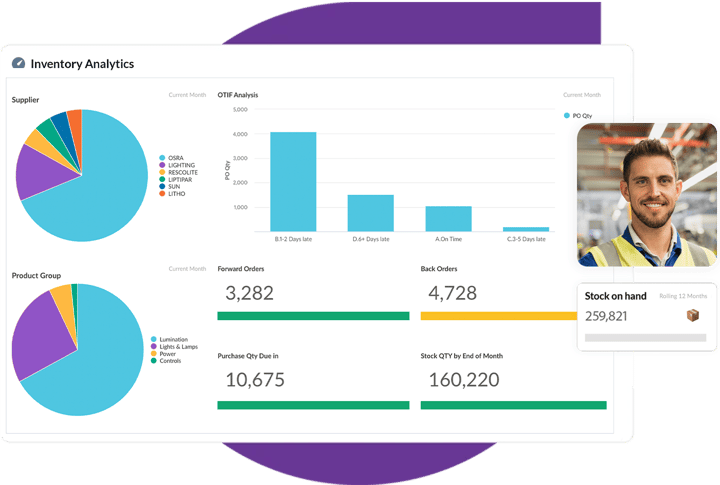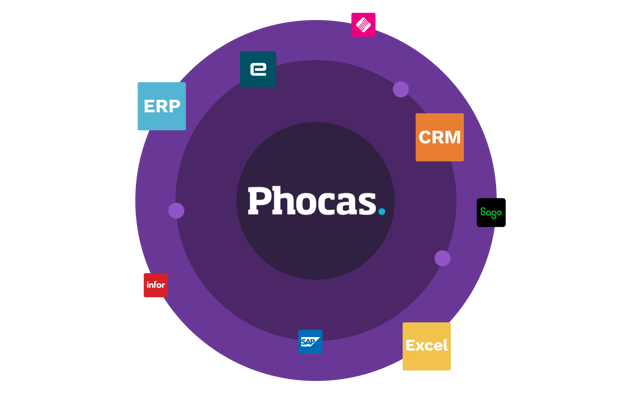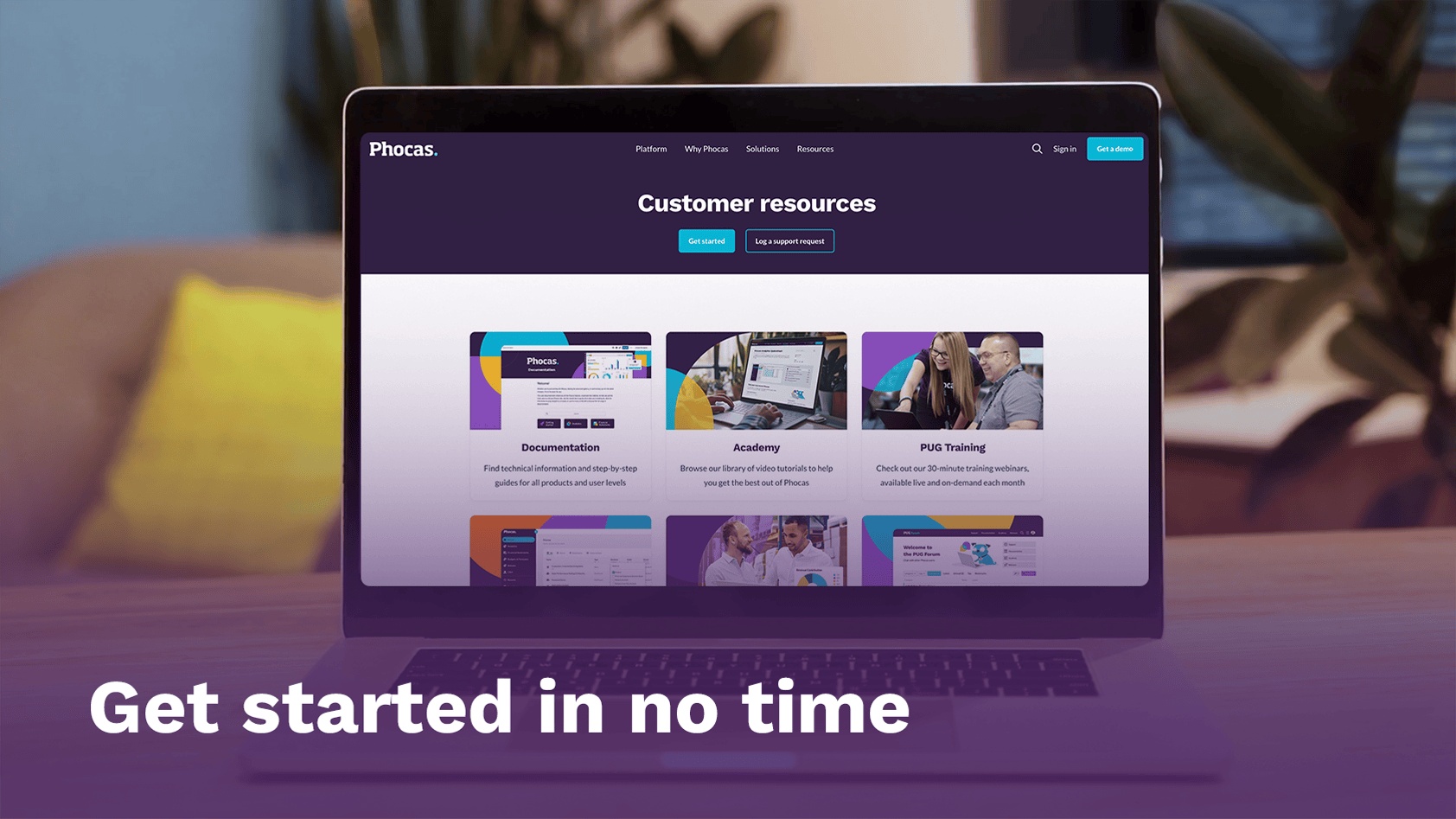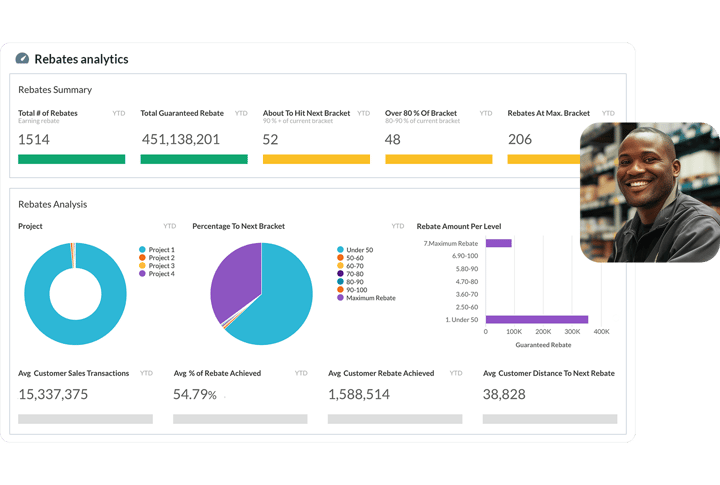Boost IFS with real-time business intelligence


Made to enhance your IFS ERP
IFS is great at running your operations, managing production, service management and financials in one system. But like most ERPs, it's not built to handle heavy analytics or flexible reporting inside the same database that runs your day-to-day transactions. That's why even IFS recommends reporting and analytics live outside the live ERP to avoid slowing down perfromance. Phocas does this by design – automatically bringing your IFS data + any other source together.
- No strain on IFS: Your ERP stays focused on core business process and operations. Phocas handles the analytics load with no lag.
- All data together: Phocas automatically connects IFS with other key systems; CRM, HRIS, even Excel files – delivering one accurate view of performance.
- Automated updates: Data flows securely from IFS into Phocas on a schedule you choose.
- One version of truth: Instead of people building their own Excel sheets or separate reports, Phocas keeps everyone aligned around the same data.
- Built for self-serve: With analytics running outside the IFS ERP, you don't need IT to build or maintain reports. Everyne can build, customize, explore and drill into the detail.

Extend IFS, with Phocas
IFS

- Data consolidation
Connects core business functions but external data sources require manual handling - User experience
Pre-set ERP reports or exports, often managed by a central team - Inventory management
Standard inventory tracking by SKU or warehouse - Financial reporting
Static ERP reports need exporting & manual manipulation for deeper analysis - Dashboards
Limited native ERP visuals
Phocas

- Data consolidation
Automatically pulls ERP data + other sources (CRM, sales, HRIS, multiple spreadsheets) into one view - User experience
All business users empowered with AI-assisted BI analytics, self-serve custom reporting & planning - Inventory management
Live visual dashboards show real-time inventory across plants, warehouses & production lines - Financial reporting
Live profit & loss, balance sheet & cashflow with full drill down and easy customization - Dashboards
Unlimited, fully customizable interactive dashboards with drill-down to transaction data
| IFS vs Phocas |  |  |
|---|---|---|
| Data consolidation | Connects core business functions but external data sources require manual handling | Automatically pulls ERP data + other sources (CRM, sales, HRIS, multiple spreadsheets) into one view |
| User experience | Pre-set ERP reports or exports, often managed by a central team | All business users empowered with AI-assisted BI analytics, self-serve custom reporting & planning |
| Inventory management | Standard inventory tracking by SKU or warehouse | Live visual dashboards show real-time inventory across plants, warehouses & production lines |
| Financial reporting | Static ERP reports need exporting & manual manipulation for deeper analysis | Live profit & loss, balance sheet & cashflow with full drill down and easy customization |
| Dashboards | Limited native ERP visuals | Unlimited, fully customizable interactive dashboards with drill-down to transaction data |
| Talk to an IFS + Phocas expert |
Self-serve analytics & reporting
Like many ERP systems, IFS includes standard, static reports for operational needs. Generating custom, ad-hoc reports often requires exporting data to Excel or relying on IT support. Phocas complements IFS by providing a user-friendly analytics layer on top of your ERP data. With Phocas connected to IFS, everyone can build custom reports, monitor KPIs and explore data in seconds.
- Automation: Live operational + financial data means no more manual entry or re-running outdated spreadsheets.
- Flexible: Create and automate profit & loss, balance sheet and cashflow statements for different departments.
- Real-time insights: Monitor KPIs across departments, save as favourites and set up ongoing alerts.
- Detailed visibility: slice and dice data, drill down by branch, division, sales rep or product for instant answers.
- Custom calculations: Add metrics like gross profit per sales order or inventory days on hand that auto update.

Customer quote
Fast, accurate data
- Automated: Live data from your IFS ERP, multiple countries, warehouses, accounting systems or even additional ERPs is pulled into one secure platform.
- Reliable performance: Handles big data volumes without lag - scaling alongside your business growth.
- Secure: Data is accessible to everyone who needs it, while finance maintains employee-level security to protect sensitive information.
- Migration: Supports earlier IFS ERP versions like applications 9 and 10, providing uninterrupted dataflow, reporting and dashboards before, during and after your migration to IFS Cloud.
- AI-assisted Analytics: fast-track data analysis for new users by asking questions like; ‘Which products had the highest increase in sales last quarter?’

Take a Phocas product tour
-
 Analytics
Analytics -
 Financial Statements
Financial Statements -
 Budgets & Forecasts
Budgets & Forecasts -
 Platform
Platform
Fast implementation, rapid ROI
- Dedicated support: An implementation team is assigned to work alongside your business to deliver a tailored, pre-built solution.
- Experienced integration: Pre-built connectors for leading ERPs; IFS, Klipboard, Sage, SAP, Infor, NetSuite, Epicor + many more to align with your existing technology.
- Data security: Secure data warehousing for multiple sources; one central, reliable data platform for your growing needs.
- Accelerated insights: Begin harnessing meaningful insights in approximately 8 weeks for a mid-size business.

Clear, reliable implementation timeline
-
Pre-launch
Week 1Meet Phocas team and confirm project scope, data sources and timelines
-
Build
Weeks 2-4Create your Phocas cloud environment and connect to ERP data
-
Validation
Weeks 3-5High-level validation and tests
-
Launch
Weeks 6-8Ongoing data validation training and launch
-
-
Pre-launch
Week 1Meet Phocas team and confirm project scope, data sources and timelines
-
Build
Weeks 2-4Create your Phocas cloud environment and connect to ERP data
-
Validation
Weeks 3-5High-level validation and tests
-
Launch
Weeks 6-8Ongoing data validation training and launch
Smooth IFS Cloud migration
- Avoid downtime: Keep critical reports and dashboards available throughout migration.
- Preserve data integrity: Phocas stores and validates data independently of the ERP so nothing is lost or corrupted.
- Compare systems side by side: Check historical and new IFS data for consistency and catch issues early.
- Uninterupted dataflow: Users continue analyzing, budgeting and forecasting without waiting for the new ERP to go live.

Phocas played a critical role in our ERP migration
Changing an ERP is a significant investment for any business, and for B&R, the implementation took more than a year to complete. B&R’s sales reporting was consistent all the way through the install because of a long-term commitment to Phocas.
Boost production & inventory insight
IFS Cloud keeps production and inventory running smoothly. Phocas builds on that, turning your IFS data into forward-looking insight. Helping you plan smarter, cut waste, protect margins and improve supplier and stock performance across the supply chain.
- Monitor stock & materials: See real-time inventory across plants, warehouses and production lines with accessible, self-serve dashboards.
- Forecast demand: Use IFS data to analyze seasonal patterns, production cycles and customer trends so you can accurately plan raw materials and finished goods.
- Track performance: Compare supplier lead times, delivery reliability and production output to spot inefficiencies early.
- Maximize profitability: Link stock, sales and margin data to make smarter purchasing and pricing decisions, keeping inventory lean and profitable.

Detailed tracking of inventory movement
"Phocas has helped us to analyze stock that isn't moving or is moving slowly, so we can move stock around to make the best use of it. This also helps us ensure our suppliers are stocking the right products for us or to plan our deliveries proportionately."
— Mark Law, IT Director at Hayley Group.

Streamline budgets & forecasts
IFS provides the basics for financial planning, with budgets and forecasts built from core ERP data. But most planning is done through static reports and spreadsheet exports, which limits flexibility and makes forecasting slow and manual. Phocas brings planning to life by connecting directly to IFS and turning financials into a dynamic, collaborative process.
- Flexible: Build detailed financial, sales and operational budgets in a familiar, spreadsheet-like interface – no manual errors and version control issues.
- Automated: Live IFS data feeds every budget and forecast, so numbers are accurate and always up to date.
- Collaborative: Assign tasks, gather input and approve budgets across departments in one central place.
- Connected: Link financial budgets with sales forecasts, headcount plans and demand planning for a complete view of performance.


Scale faster with Phocas
When growth demanded more from the finance team, US manufacturer IMMY chose Phocas over additional hires. The result? Faster reporting, streamlined divisional budgets and confident data-driven decisions – like acquiring another company and restructuring departments.
Phocas helps IMMY move fast with accurate, consolidated data, live budgets and powerful scenario planning.
Customer quote

Trusted by companies worldwide
The Phocas platform empowers over 3,000 businesses who make, move and sell products. 97% of customers stay with us year-on-year because our platform gives people confidence to run their businesses better.
- Asko
- Bayer
- Bupa
- Fuji Xerox
- Gazman
- Repco
- Sistema
- Thermofisher
- Hoyts
- KYB
- Husqvarna
- Johnstone Supply
- Karcher
- WD-40
- Yamaha
- Bunzl
See how Phocas compares with other providers
Power BI vs Phocas


Tableau vs Phocas


QlikView vs Phocas


Looker vs Phocas


Sisense vs Phocas


Jedox vs Phocas


Boost rebates profitability
- Automated: stay on top of payable and receivable rebates with a self-serve tool that speeds up rebate management
- Accurate: prevent overpayments or under claiming rebates with real-time data and automated calculations
- Improved analysis: review rebate programs including structure – are they driving sales, and view impact on profit and margin in one place
- Win-win partnerships: track customer target accruals, use near-miss analysis, explore ‘what if’ scenarios and showcase potential earnings in person

Accurately forecast demand
- Detailed: analyze patterns for different market segments such as customer demand by product class, geography, sales channel, purchase history
- Reforecast: easy access to live actuals empowers teams to adjust forecasts to align with changing inventory needs
- Seasonal: tap into historical data and analyze your seasonal sales trends to create more accurate inventory forecasts
- Review: easily review your forecast accuracy by comparing it to actuals

An end-to-end platform to boost IFS
Frequently asked questions
Yes - Phocas specializes in combining business data, most often ERP and financial data, with other non financial data sources. Providing one trusted platform to measure, track and plan your ongoing business operations quickly and easily.
Phocas started as a BI solution, so we understand the ins and outs of data manipulation. Our customers loved the enhanced capabilities that Phocas brought to their ERP that they started asking for financial analysis and budgeting and forecasting capabilities too.
Our focus is creating software and tools that anyone in your organization can use to understand sales, operations and logistics, making sure that your team can plan and forecast based on a solid foundation of trustworthy data.
Data analytics, or business intelligence (BI), is the process of interpreting key business data to understand how an organization is performing, both financially and operationally.
Data analytics software is designed to retrieve, analyze, transform, and report on business data and metrics. This software provides organizations with an integrated view of their overall business by combining multiple data sets, such as enterprise resource planning (ERP) systems, CRM, HR, Payroll and e-commerce. BI can also be used to identify trends, uncover insights, and make informed business decisions.
This is the process by which businesses regularly plan, review and control their finances.
The budget is a company's financial plan of intent for 12-months. This will incorporate data from finance, operations, sales, inventory and other company information to enable them to set goals and to monitor and manage their finances.
The forecast is a more detailed financial plan for a set amount of time, such as the last 6 or 3 months of the financial year.
Budget forecasting is when businesses regularly track actual performance numbers and compare them to the budget. Any insights or risks gleamed from this assessment can then be used to re-forecast the remainder of the budget period. This way, potential issues can be mitigated before they become a major risk, or swift action can be taken when responding to rapid economic or environmental change.
When you’re armed with this information in real-time, you have more control of your financial position throughout the year. It also enables you to take take action to avoid greater risks in the long term, while at the same time helping you to achieve your business goals.
Financial statement software is a program designed to automate the process of creating reports such as profit and loss (income statement), balance sheet and cashflow statements. It achieves this through the extraction of real-time data from ERP, CRM and multiple other data sources, and helps to ensure accuracy, consistency, and compliance with accounting standards.
Statements are fully customizable to suit your business needs with an intuitive interface that enables free-form data analysis. Visualizations such as dashboards, graphs, charts and Sparklines also help to connect the wider business to performance as it's easy to provide an at-a-glance view of your finances.
There are several benefits of using financial data analysis platform over Excel or other manual reporting methods:
-
Time-saving: It frees up the finance team from time-consuming reporting tasks by automating entire processes, allowing for faster reporting, consolidation, and customization.
-
Accuracy: Data is pulled directly into the platform which ensures accuracy and reduces the risk of errors that can occur when maintaining and reworking static spreadsheets.
-
Standardization: It enforces standardization across financial statements, budgets and reports to ensure consistency and enables comparisons across different periods.
-
Collaboration: It enables teams to collaborate and work simultaneously in a secure and auditable environment. This can improve communication and reduce the risk of data discrepancies.
-
Reporting: It provides advanced reporting capabilities, such as customizable templates and interactive dashboards. This makes it easier to visualize data and identify patterns and trends.
-
Security: It provides better security features than Excel, including data encryption, user access controls, and audit trails. This can help protect sensitive financial data from unauthorized access or modification.
- Customizable: You can add calculations to the statements such as EBIT, margins and ratios.
While Excel can be a useful financial reporting tool, a complete suite of analysis, financial statement and forecasting tools can help businesses streamline their financial reporting processes, improve accuracy, and make better, faster decisions based on real-time data.
Understand the past, operate better today, and plan well for the future




































